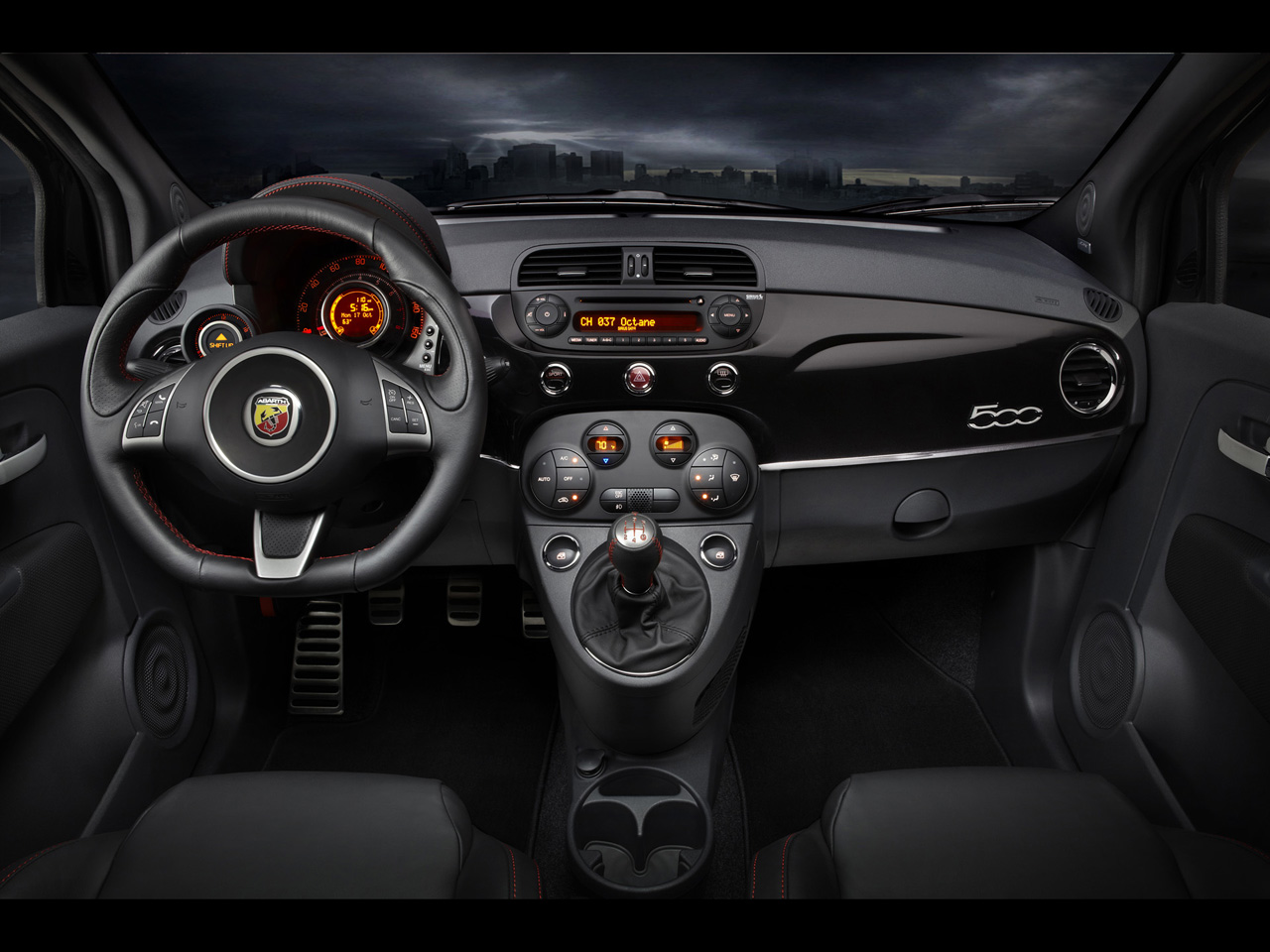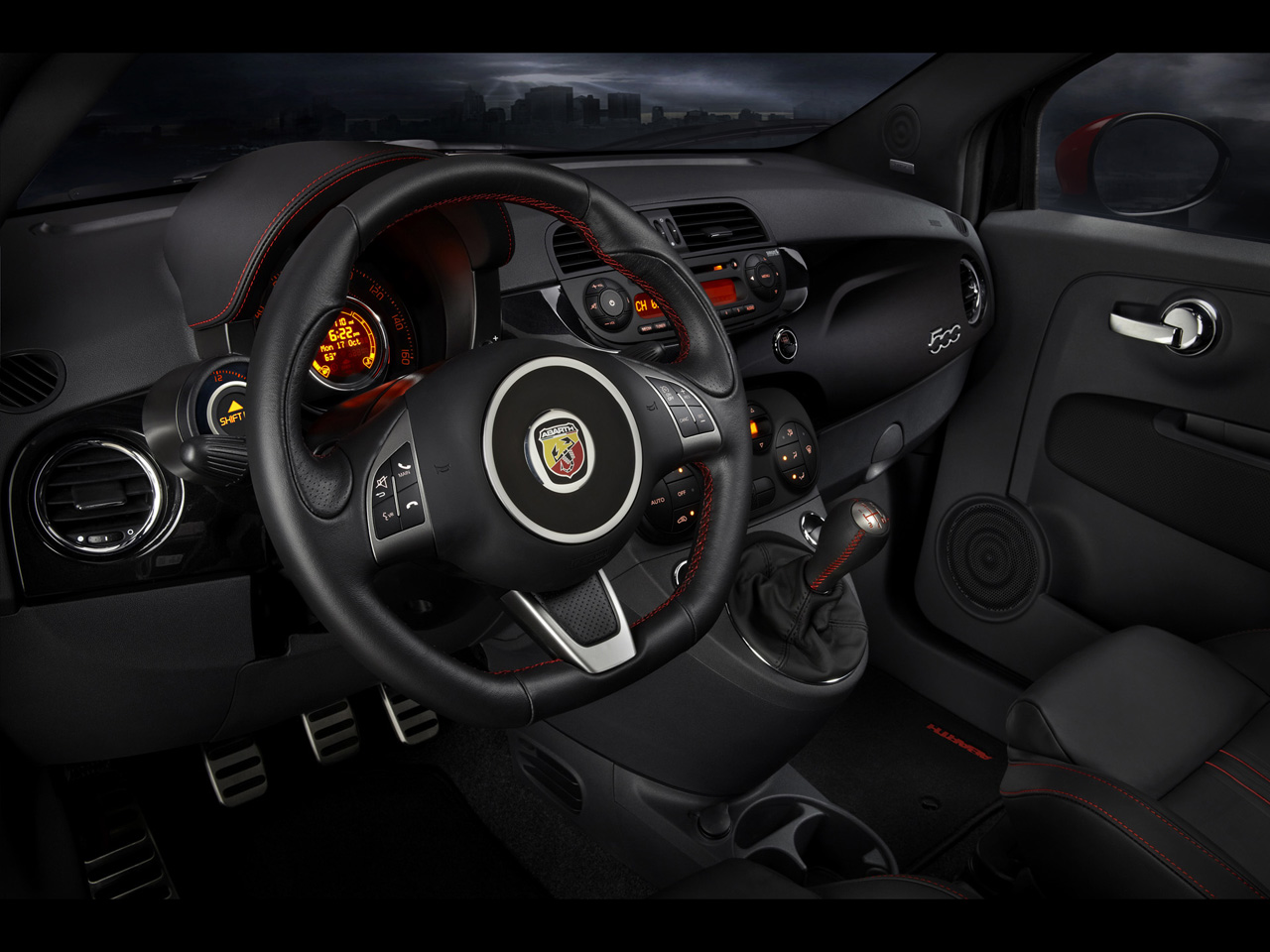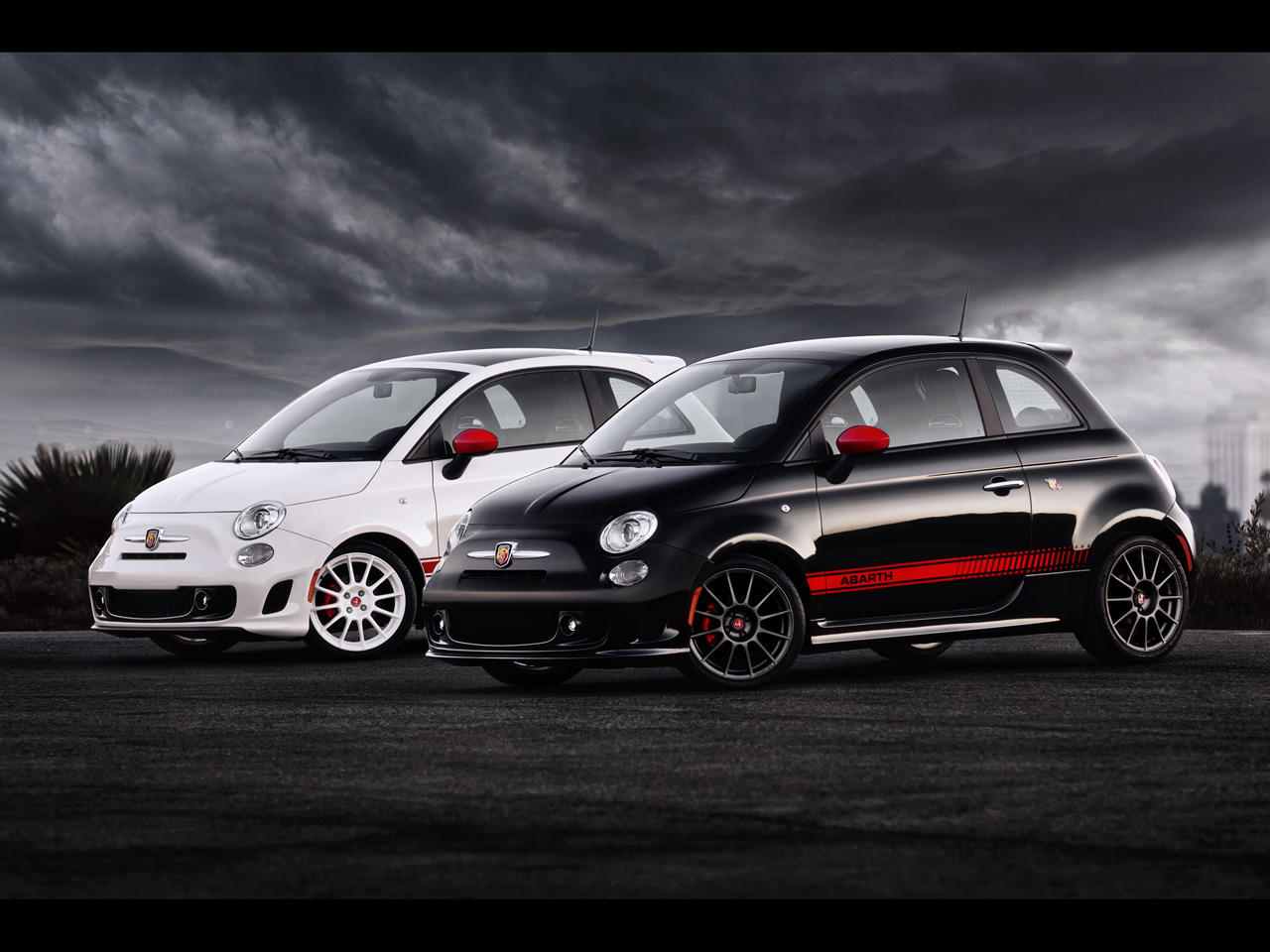2012 Fiat 500 Abarth
|
Price |
-- |
Production |
-- | ||
|
Engine |
1.4 liter inline-4 |
Weight |
-- | ||
|
Aspiration |
turbocharged |
Torque |
170 lb-ft | ||
|
HP |
160 hp |
HP/Weight |
-- | ||
|
HP/Liter |
114.3 hp per liter |
1/4 mile |
-- | ||
|
0-62 mph |
-- |
Top Speed |
-- |
(from Chrysler Press
Release) 2012 Fiat 500 Abarth: INTRODUCTION
Faithful to the “small but wicked” saying coined for Karl Abarth’s
cars in the 1960s, the new 2012 Fiat 500 Abarth arrives to America
with the racing traditions that have made it a success on European
roadways and racetracks — world-class performance and precision,
purposeful and aggressive styling, high power-to-weight ratio and
limited-production volume.
“Bringing the 2012 Fiat 500 Abarth to the U.S. enables us to reach
out to driving enthusiasts who want Italian performance at an
attainable price,” said Olivier Francois, Head of FIAT Brand and
Chief Marketing Officer — Chrysler Group LLC. “With its lightweight,
track-tuned handling and purpose-built design, the Fiat 500 Abarth
brings to life the legendary racing heritage of the brand and
becomes the Italian high-performance car for everyday driving.”
Building on the excitement of the new 2012 Fiat 500 (Cinquecento),
the new Fiat 500 Abarth is designed for track-day enthusiasts and
driving purists who want the ultimate high-performance small car
with the pedigree of an exclusive Italian exotic.
With its all-new 1.4-liter MultiAir® Turbo engine, Abarth-tuned
suspension and brake systems, race-inspired design, and technology
features not traditionally included on a small car, the new 2012
Fiat 500 Abarth unleashes the brand’s legendary performance heritage
to American streets.
“Abarth treatment” and tradition continues to deliver extraordinary results
In the late 1950s Karl
Abarth believed that race cars with brilliant performance could be
derived from small, lightweight, everyday driving cars — including
the original Cinquecento (500). And his tradition of track-ready
small cars continues today by utilizing the 2012 Fiat 500 Sport as a
base point for the new high-performance Fiat 500 Abarth.
Staying faithful to the performance principles that made the Abarth
name a success, the new Fiat 500 Abarth continues the brand’s
motorsport traditions, including:
Everyday
Performance Car
Track-ready capability, high horsepower-per-liter engine,
combined with the quality, efficiency and refinement expected in
a world-class small car
Competitive
Benchmark levels of performance, track-proven reliability
and durability
Aggressive
Purposeful and functional performance design, Abarth-tuned
powertrain control module (PCM) and performance-tuned exhaust
with menacing sound
Attainable
State-of-the-art powertrain and chassis technology once
limited to premium-priced performance cars
Racing Heritage
More than 60 years of performance and competition tuning,
including active international series races today
Engineering
Development vehicles raced “round-the-clock” in 24-hour
endurance challenges to prove durability
Like the European model,
the new 2012 Fiat 500 Abarth is designed, engineered and tested to
deliver the high-performance driving and enduring capabilities
needed for track use. And to make sure the 500 Abarth provides the
highest levels of driving thrill, every piece of hardware and every
mile of development tuning has been thoroughly examined to ensure
the European model’s DNA is delivered to North American driving
enthusiasts.
“The new 2012 Fiat 500 Abarth is more than the addition of power and
world-class technology, it’s designed, developed and tuned to
deliver the responsiveness, control and precision a performance
driver wants and expects,” said Joe Grace, Vehicle Line Executive,
Fiat 500 Abarth. “And for our owners who plan on testing the car’s
high-performance capabilities and limits, we have continued to
develop from the proven European models to ensure the new 500 Abarth
endures on the track.”
Like the European-spec 500 Abarth derived from the standard
Cinquecento, the 2012 Fiat 500 Abarth builds off the North American
adapted Fiat 500 Sport – and adds the legendary performance and
handling capabilities that have made Abarth models an international
success both on and off the track.
Track ready, precision-tuned chassis
The new 2012 Fiat 500
Abarth features an enhanced front- and rear-suspension design to
deliver the precision handling, steering and refinement needed for
high-performance driving.
Compared with the front-suspension design of the Fiat 500 Sport
model, the new 500 Abarth features a unique MacPherson suspension
design with a 40 percent stiffer spring rate and 0.6-inch (15 mm)
lower ride height for improved handling and minimal body roll.
Abarth-designed cast iron front-lower control arms provide improved
lateral stiffness, while an increase in negative camber to -1.5
degrees delivers improved grip and steering precision.
New dual-valve Frequency Selective Damping (FSD) KONI® front-shock
absorbers replace standard twin-tube units and deliver an innovative
two-in-one solution. This patented technology provides the
road-holding and handling characteristics needed for maximum grip
and performance. In addition, the FSD system actively filters out
high-frequency suspension inputs from uneven road surfaces and
adjusts for improved comfort and smoothness.
The beefier rear-suspension design of the Fiat 500 Abarth takes the
Fiat 500 Sport model’s (already 300 percent stiffer than the
European Fiat 500) twist-beam design further, with a reinforced rear
axle with strengthened coil-spring supports for greater durability.
A new Abarth-specific rear-stabilizer bar increases cornering grip.
For improved handling, minimal body roll and ride-height control
(when fully loaded), the new Fiat 500 Abarth features 20 percent
stiffer rear springs with 0.6-inch (15 mm) lower ride.
Abarth-tuned steering
The new 2012 Fiat 500 Abarth features a 15.1:1 (up from 16.3:1) steering-gear ratio for 10 percent quicker steering to enhance responsiveness, maneuverability and high-performance feel. Compared to the Fiat 500 Sport, the 500 Abarth features a uniquely tuned electronic power steering (EPS) calibration for increased steering response and feedback.
Track-proven brake system
The Fiat 500 Abarth
features a high-performance brake system with an Abarth-tuned
electronic stability control (ESC) system designed for at-the-limit
driving.
At the front, the Fiat 500 Abarth features 2.1-inch (54 mm) diameter
single-piston front-brake calipers with semi-metallic brake linings
for greater stopping power. Larger 11.1-inch (282 mm) (up from
10.1-inch; 257 mm) diameter ventilated rotors provide additional
surface-heat dissipation. The 9.4-inch (240 mm) rear disc-brake
system features single-piston brake calipers with semi-metallic
brake linings to mitigate brake fade at higher temperatures. Both
front- and rear-brake calipers are lacquered in Rosso paint for an
athletic look.
An Abarth-tuned ESC system features a three-mode calibration to
maximize the new 2012 Fiat 500 Abarth’s handling capabilities on and
off the track. When ESC is selected from “On” to “Partial Off” or
“Full Off” on the instrument panel, the 500 Abarth’s innovative
Torque Transfer Control (TTC) system maximizes throttle performance
during on-throttle cornering.
Lightweight wheels with high-performance tires
Standard on the 2012
Fiat 500 Abarth, 16 x 6.5-inch cast-aluminum wheels feature a
race-inspired design and are fitted with 195/45 R16 Pirelli®
Cinturato P7 tires that deliver all-season traction and low-noise
characteristics. These tires are inflated with a higher tire
pressure to optimize the 500 Abarth’s suspension tuning.
For even more performance, larger and wider 17 x 7-inch wheels are
available on the Fiat 500 Abarth. With forged-aluminum construction,
these race-inspired wheels keep this Cinquecento lightweight at each
corner (18.9 lbs. compared to the standard 16-inch wheels at 18.3
lbs.), while delivering strength and track-tested durability. When
equipped with these larger wheels, high-performance three-season
Pirelli P-Zero Nero tires feature a 205/40 R17 sizing for a wider
stance and a reduced profile for improved handling.
Putting the new 2012 Fiat 500 Abarth to the test
Public road and race
track reliability and durability testing, initially done by FIAT
prior to the Fiat 500 Abarth’s European launch, was conducted again
in North America to validate the recent engineering changes, as well
as to collect feedback from American drivers.
In addition to the 4 million development miles (6.4 million
kilometers) of the North American Fiat 500, plus the quality-proven
engineering of the European 500 Abarth, the new 2012 Fiat 500 Abarth
added more than 2 million additional miles (3.2 million kilometers)
during its reliability and durability evaluations at the Chrysler
Group’s scientific labs, proving grounds, race tracks and on public
roads in various climates.
The fleet of early production Fiat 500 Abarth vehicles was tested
day and night on various public road surfaces in different North
American climates to identify any potential reliability issues.
Chrysler Group’s trained drivers also scrutinize functional aspects
of each vehicle, such as heating and ventilation systems, storage
compartments and window operation. The development team reviews the
test results each day and makes any necessary adjustments to ensure
the quality of customer vehicles.
Taking a page out of Chrysler Group’s SRT® brand’s durability test
manual, engineers subjected Fiat 500 Abarth prototypes to 24-hour
endurance events on the harsh surfaces of the Nelson Ledges Road
Course in eastern Ohio. Even with a high-end performance car, many
race drivers consider it a feat to finish a 24-hour endurance race
without brake system, engine or suspension failures. The Abarth
prototypes not only survived the challenge, but delivered dependable
performance as they clocked consistent lap times from start to
finish.
160 Horsepower (117 horsepower/liter) with new 1.4-liter MultiAir® turbo engine
Taking a page from Karl
Abarth’s extensive experience to increase the power and durability
of the original Cinquecento’s engine for racing use, the new 2012
Fiat 500 Abarth debuts a turbocharged variant of the proven
1.4-liter MultiAir® engine for increased horsepower, torque and
performance.
“With the addition of a turbocharger to the 1.4-liter engine,
advanced intake technology including FIAT’s exclusive MultiAir
system, a heavy-duty five-speed manual transmission and a host of
other internal refinements to the powertrain, the 2012 Fiat 500
Abarth transforms the Fiat 500 into a high-performance precision
driving machine that every enthusiast will appreciate,” said Mike
Vincent, Platform Manager for the 1.4-liter MultiAir Turbo engine.
Behind the unique Rosso (red) Abarth engine cover and Abarth-designed
front fascia with twin “nostrils,” lies the heart of the 2012 Fiat
500 Abarth – the all-new 1.4-liter MultiAir Turbo engine backed with
a stronger, manual five-speed transmission, equal-length half
shafts, 3.35 final-drive ratio, and a Torque Transfer Control (TTC)
system that delivers power to the pavement.
High-performance engine design with high output
Selected as the “Best
International Engine in 2010,” by a panel of 72 journalists from 36
countries, the new 1.4-liter MultiAir Turbo engine in the Fiat 500
Abarth is designed to meet the rigorous demands of performance
driving throughout its 6,500 rpm range.
Structurally, the 1.4-liter MultiAir Turbo engine starts with a
cast-iron block and an aluminum bedplate. Bore is 72 mm (2.83
inches) and stroke is 84 mm (3.31 inches) for a total displacement
of 1368 cu. cm (83.5 cu. in.).
At the bottom end, a forged-steel crankshaft with select-fit main
bearings is supported across four main journals. The crankshaft has
been designed with lightened counterweights to reduce overall mass
for high engine rpm operation.
Durability is ensured with the use of lightweight forged-steel
connecting rods that have been designed with a unique cross section
to minimize the longitudinal and lateral bending of the rod.
Lightweight pistons contribute to the overall strength of the
reciprocating assembly and the engine’s high rpm capability.
Full-floating piston pins are used for added strength. Piston
cooling jets, located at the bottom of each cylinder, contribute to
fuel economy by squirting oil on the bottom of the pistons to help
maintain cylinder temperatures and reduce the possibility of hot
spots along the cylinder walls or at the top of the piston that
could lead to detonation.
Compression ratio of the Fiat 500 Abarth’s 1.4-liter MultiAir Turbo
engine is 9.8:1. For optimum fuel economy and performance, fuel with
a 91 octane rating is preferred and regular 87 octane is acceptable.
This high-performance 1.4-liter engine also is fitted with a
structural aluminum oil pan. Crankcase capacity is 4.0 quarts with a
dry filter. Synthetic 5W-40 engine oil is recommended, due to higher
overall temperatures with the turbocharger. And to maintain a lower
ownership cost for the Fiat 500 Abarth, oil change intervals are set
at 8,000 miles.
Innovative MultiAir® cylinder head
The valve train for the
high-performance 1.4-liter MultiAir Turbo engine features FIAT’s
exclusive MultiAir fuel delivery technology. Unlike engines that
rely on direct action from fixed lobes on the camshaft to control
intake valve opening and closing, MultiAir is an electro-hydraulic
system that can control intake air, cylinder by cylinder and stroke
by stroke depending on the demands from the standard electronic
throttle control (ETC) system.
Actual opening of the valves is controlled by hydraulic fluid
running through a narrow passage that is controlled by a dual-action
solenoid. When the solenoid is closed, under highway speeds or full
acceleration, intake valves are fully open much like a traditional
engine for maximum power. At lower speeds, the solenoid opens,
allowing oil to bypass the passage, decoupling the valves. This
allows for infinite control of the valves and controls the amount of
fresh air into the cylinders, reducing wasted energy that is common
with fixed intake lobes on a camshaft.
Spent exhaust gases are released through traditional lobes on the
camshaft and exit through a cast stainless steel exhaust manifold.
Ignition is through a single output, coil-on-plug system. Spark
plugs are dual precious metal for durability.
Fuel delivery is sequential, multi-port, electronic, with injectors
located to direct the fuel spray at the intake valves in a wide
spray pattern that increases fuel atomization and enhances complete
combustion for a smooth driving experience.
MultiAir technology on normally-aspirated 1.4-liter engines provides
15 percent increase in low engine rpm torque, 7.5 percent
improvement in fuel efficiency and a 10 percent reduction in CO2
emissions.
Turbo and twin intercoolers provide 160 horsepower*
Compared with the Fiat
500’s natural-aspirated 1.4-liter MultiAir engine, the boost to an
estimated 160 horsepower on the new 2012 Fiat 500 Abarth is largely
due to its single turbocharger that operates off engine exhaust and
utilizes energy that would normally be wasted through the tailpipe.
The turbocharger spins up to 230,000 rpm to convert exhaust heat and
pressure to a rotational force that drives a compressor. The
compressor draws cool air and pumps it into the intake manifold at
increased pressure that results in a greater amount of air in the
cylinder and hence more power.
The 1.4-liter MultiAir Turbo’s induction system includes two
intercoolers located behind the driver- and passenger-side air
inlets of the Abarth-styled front fascia. The intercoolers are
designed to remove heat in the air charge that the turbocharger
generates while compressing incoming air (higher air density for
more power). Reducing heat provides a cooler, denser air charge that
helps increase the potential for more power. A cooler air charge
also reduces the potential for engine knock.
High-performance engine system components
The new 2012 Fiat 500
Abarth features several engine system component upgrades needed for
high-performance driving.
On the intake side, the 1.4-liter MultiAir Turbo features an Abarth-designed
fresh-air intake system with high-flow air filter, redesigned air
box for improved air flow and smooth-flowing plumbing for maximum
power and low induction noise.
An Abarth-designed concentric “double tip” dual-exhaust system
delivers a high-performance look with menacing Abarth-tuned sound
and minimal exhaust gas restriction for maximum power.
An Abarth-tuned powertrain control module (PCM) integrates all of
the MultiAir Turbo’s engine control functions. The PCM provides
specific engine calibrations to maximize horsepower and torque in
“Sport” mode, and syncs with the LED-illuminated shift light for
additional driver notification at the redline.
An upgraded electrical system includes a high-output 140-amp
alternator and 500 amp cold-cranking maintenance-free battery for
increased vehicle system charging.
High-performance transmission and driveline
Developed by Fiat
Powertrain Technologies (FPT) for high-output applications, the Fiat
500 Abarth is equipped with the heavy-duty C510 five-speed manual
transmission. Proven on the European 500 Abarth models, this
transmission features a 3.35 final-drive ratio for quick
acceleration and faster top speed, while maintaining fuel
efficiency.
Designed to handle the increased torque loads, the Fiat 500 Abarth’s
C510 transmission includes an intermediate shaft with equal-length
half shafts to mitigate torque steer. Compared with the Fiat 500,
the 500 Abarth features 23 percent larger half shafts (28.1 mm
diameter vs. 22.8 mm diameter in the Fiat 500) for increased
strength and to reduce torsional stress in the driveline during
performance driving on the road or track. To handle the increased
power and torque of the new 1.4-liter MultiAir Turbo engine, larger
constant velocity (CV) joints with 53 percent greater torsional
strength (2600 N•m vs. 1700 N•m in the Fiat 500) deliver added
durability and refinement.
Maximum track handling with Torque Transfer Control (TTC) system
Helping the driver to
utilize the power of the new 1.4-liter MultiAir Turbo engine is an
Abarth-tuned Torque Transfer Control (TTC) system. TTC is designed
to control and transfer the engine’s torque to the drive wheels for
world-class performance and improved at-the-limit handling.
The TTC system in the 2012 Fiat 500 Abarth features a differential
locking system that uses the mechanical differential in the C510
transmission to control torque via the electronic stability control
(ESC) system. Utilizing ESC enables the 500 Abarth to transfer
torque from a front wheel that slips, to one that grips.
In addition, when the Fiat 500 Abarth is in “Sport” mode, TTC
automatically adjusts the degree of differential locking depending
on dynamic factors, including vehicle speed.



